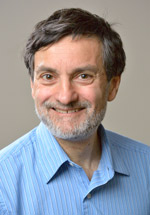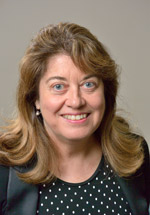Gratton, Fabiani Find Success as Research and Life Partners
Though never planned, it was probably destiny that Gabriele Gratton and Monica Fabiani would become inextricably linked as research partners. The interweaving of science and education with family is part of the ancestral histories for both of these full-time Beckman Institute researchers.
Gratton and Fabiani have been married for 28 years, departing their native Italy shortly after their wedding ceremony for graduate school at the University of Illinois. Through a journey that included Ph.D.s for both, a return to Italy, stints in industry, and, finally, tenure-track positions in academia at the University of Missouri, they pursued research interests that for the most part were parallel but essentially separate.
It was at Missouri, however, that they were asked to share a lab. By the time Illinois started recruiting them in 2001 with an offer that included faculty positions at the Beckman Institute, Fabiani and Gratton were starting to be thought of in neuroscience research circles as a team.
“We used to have fairly separate lines of research,” said Fabiani, who is also Co-chair of the Biological Intelligence research initiative at Beckman. But, she said, with the joint lab came “all sorts of joint decisions. By now it’s actually a plus. At the time it was more convenient (for the department) but once you are in one lab and you have to co-direct the lab, then the research becomes much more overlapping.”
“However,” Gratton quickly adds, “even now, although we work together on most projects, we end up having somewhat different orientations. Monica is working on aging research and applications to aging problems. My work has been more on technological development: optical imaging (EROS) and other statistical analyses and methods. We ended up integrating these two lines in all sorts of ways.”
While it may have begun as a collaboration of necessity, it is no surprise – based on their backgrounds – that this husband-and-wife team also became a research team. They grew up in Frascati, a small town outside of Rome known for its scientific research centers and educational atmosphere. Gratton’s father was a professor of astrophysics and science infused his upbringing, with intellectual matters a normal part of the nightly dinner conversation.
“For me that forged my life,” said Gratton, who also earned an M.D. degree in his native Italy. “I was used to having professors around my house and I could see my future life in academia.”
“That doesn’t quite describe it,” Fabiani added. “You had dinner with the department of physics every night.”
“Yes, it was physics and astrophysics,” he said. “I met people who won the Nobel Prize when I was a kid so I was exposed to this type of environment since I was little.”
Fabiani describes her own upbringing as more “normal in some ways” but adds that her family history includes the atypical fact of having many highly-educated women among her ancestors. Fabiani’s mother, grandmother, and great-grandmother were teachers and her aunt was a chief of neurology. It was that aunt who played a role in Fabiani becoming interested in neuroscience, beginning with a memorable meal at a vacation lake house.
“I enrolled in psychology thinking of becoming a clinical psychologist,” she said. “I went on vacation with her at a lake resort in northern Italy right before I started my freshman year in college and there was a flood. We were sitting there having lunch in the hotel because there was a flood, which was typical for a vacation with my aunt, and we couldn’t go anywhere. She made me eat fried brains, which are considered a delicacy there, but I didn’t particularly like it. While we were doing that she was telling me about the central nervous system and I thought it was fascinating.
“But I never ate any brains again,” she added with a laugh.
Fabiani’s interest in the brain today is purely scientific. She and Gratton are professors of psychology and full-time faculty members of Beckman’s Cognitive Neuroscience group. They are considered leaders in the use of various neuroimaging methods, especially optical imaging, to study topics such as perception, attention, and memory. Their Cognitive Neuroimaging Laboratory at Beckman integrates traditional brain function measurements like optical spectroscopy (NIRS), functional Magnetic Resonance Imaging (fMRI), and evoked potentials (ERPs) with an optical technique they pioneered called Event-Related Optical Signal (EROS).
– Gabriele Gratton
The EROS imaging system uses near-infrared light to identify and measure changes in the light scattering and absorption properties of neurons. It is a powerful tool for analyzing brain function, especially from a temporal perspective, because of its ability to measure brain activity at a millisecond timescale.
Optical brain imaging was in its infancy when, in the 1980s, Gratton had a discussion with his brother, Enrico Gratton, who served as a Professor of Physics at the U. of I. for 30 years. He and Fabiani were looking for a method other than ERPs or fMRI to study the brain non-invasively and that conversation started them on the path to creating EROS.
“We were using ERPs (a technique which provides information about the timing of brain events, but not about their localization) at the time and we wanted to have some way besides fMRI, which wasn’t as available as it is now, to get an idea of where things are localized in the brain,” Fabiani said.
“The advantage of optical imaging is that you can get a measure every 10 milliseconds, you can get hundreds of measures every few seconds, and you can study phenomena that happen very, very quickly,” Gratton said. “The brain can act very, very quickly, so if you want to understand the function of the brain and follow activities that occur very rapidly it is very useful to have a technology that has the same temporal properties. At the same time, you can also know where the activity occurs.”
By developing the EROS system they were able to take a second look at theories that, using methods like fMRI, related brain function to blood flow, or hemodynamic activity, rather than neuronal activity.
“Technologies that image hemodynamics like fMRI are beautiful for spatial resolution but they cannot fractionate events that quickly in time,” Gratton said. “With optical imaging we can measure these events very, very rapidly. When we started measuring brain responses with EROS we realized immediately that we were picking up changes that were not only slow, hemodynamic phenomena, but also changes that were too fast to be hemodynamic.”
So the pair started focusing their research on determining if the signals they were observing could be interpreted as neuronal signals and at the reliability of their observations. Their work eventually earned them their first grant from the National Institutes of Health.
“It took awhile because people weren’t even convinced that light could go through the brain,” Fabiani said. “We started using optical measures with one idea but we saw that the phenomena didn’t correspond to the idea; it was much faster, way too fast to be hemodynamic. Because it was so fast we started thinking maybe we were seeing neuronal signals. We had to do a lot of groundwork to convince people to give us the first grant to study this further.”
Their work eventually earned Gratton and Fabiani – and their optical imaging techniques – credibility and more funding for future research and development of the EROS system. Today they are well-known for their advances in optical imaging for the study of brain function. The method has expanded to include new applications involving interdisciplinary collaborations with Beckman colleagues, such as a project with Gary Dell and Susan Garnsey applying EROS to studying language processing, and another with David Clayton studying the zebra finch songbird’s brain using a tiny helmet.
Gratton and Fabiani say the chance to do interdisciplinary work at Beckman was a big part of their decision to return to Illinois in 2001, where both had earned their Ph.D.s in psychology a decade before.
“Beckman was a big part of recruiting us,” Fabiani said. “In fact we were looking forward to collaborations with Gabriele’s brother and Andrew Webb, who have recently left but were here for about five years after we started. For us it was fairly obvious to come here. It was never really discussed we would do something else.”
“Our work has become progressively more and more interdisciplinary with time,” Gratton said. “During the period that we were away from here we became interested in developing new imaging technologies, in particular optical imaging methods, to study brain function. Developing new technologies means we are not only interested in psychological issues but also in engineering issues, physics, statistical analysis, and so on. This really requires an environment in which we collaborate with people with other types of interests and expertise.
“We ended up collaborating with many people from different backgrounds and disciplines. This is why Beckman is an incredibly important tool for us, allowing us to be part of this interdisciplinary approach.”
Their decision has been proven a success as their collaborations continue to grow, along with the number of funding grants and peer-reviewed papers. They have developed EROS into an advanced optical imaging system and Fabiani said that it is just now starting to come into its own as a tool for researchers investigating a wide variety of topics. They collaborate with a company in Champaign on designs for the system, which includes a helmet for recording data and software that has been updated many times, as the system has advanced from being able to measure part of the brain to the whole head.
– Monica Fabiani
“For us the interest is the science so we can understand how the brain works,” she said. “The development (of EROS) obviously helps because it allows us to ask questions that we couldn’t ask otherwise. For us, in the end, it’s just a tool; we’re here to pursue science.”
“I would say our progress has been enormous, especially considering that most of this work has been conducted here in our lab,” Gratton added.
Both Fabiani and Gratton are very involved with the Beckman Institute through their service on committees and through her position as a co-chair. Fabiani said she thinks those types of activities are important.
“You really gain an appreciation of the breadth and excellence of the research done here,” she said. “Because of what we have found in interdisciplinary research I would like to make sure that others have the same opportunity.”
Gratton and Fabiani say they return to Italy about once or twice a year, and keep in touch with their large family there through 2008 technologies that make the separation less difficult than when they first came here almost 30 years ago. They have one daughter who is in graduate school in California and another in high school here. Just as during their upbringing, discussions about scientific topics are a normal part of family life.
“We’ve always talked about work, even as students,” Fabiani said. “We would commute to Rome to college by train. Gabriele was in med school and I was in psychology and we would constantly talk about classes so I would know what he was studying and why. Talking to someone about work is useful and interesting. We argue and discuss ideas but it’s good to have someone to bounce ideas with because it’s someone who can give you an informed opinion.”
“I think it is our bread and butter,” Gratton said. “This is what we do all day and think about all day.”
And it looks like the family tradition will continue.
“Our oldest child is in cognitive neuroscience at Berkeley. She says this is all the effect of early exposure to brain talk at the dinner table,” Fabiani said with a laugh. “The other one said she is going to be a bioengineer, but I think she’s getting closer (to neuroscience), so we’ll see.”

